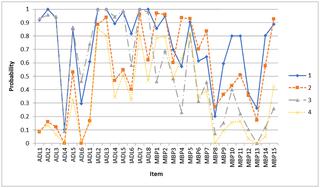Our official English website, www.x-mol.net, welcomes your
feedback! (Note: you will need to create a separate account there.)
Staging dementia based on caregiver reported patient symptoms: Implications from a latent class analysis.
PLOS ONE ( IF 2.9 ) Pub Date : 2020-01-15 , DOI: 10.1371/journal.pone.0227857 Qi Yuan 1 , Tee Hng Tan 1 , Peizhi Wang 1 , Fiona Devi 1 , Hui Lin Ong 1 , Edimansyah Abdin 1 , Magadi Harish 2 , Richard Goveas 2 , Li Ling Ng 3 , Siow Ann Chong 1 , Mythily Subramaniam 1, 4
PLOS ONE ( IF 2.9 ) Pub Date : 2020-01-15 , DOI: 10.1371/journal.pone.0227857 Qi Yuan 1 , Tee Hng Tan 1 , Peizhi Wang 1 , Fiona Devi 1 , Hui Lin Ong 1 , Edimansyah Abdin 1 , Magadi Harish 2 , Richard Goveas 2 , Li Ling Ng 3 , Siow Ann Chong 1 , Mythily Subramaniam 1, 4
Affiliation

|
BACKGROUND
Tailoring interventions to the needs of caregivers is an important feature of successful caregiver support programs. To improve cost-effectiveness, group tailoring based on the stage of dementia could be a good alternative. However, existing staging strategies mostly depend on trained professionals.
OBJECTIVE
This study aims to stage dementia based on caregiver reported symptoms of persons with dementia.
METHODS
Latent class analysis was used. The classes derived were then mapped with disease duration to define the stages. Logistic regression with receiver operating characteristic curve was used to generate the optimal cut-offs.
RESULTS
Latent class analysis suggested a 4-class solution, these four classes were named as early (25.9%), mild (25.2%), moderate (16.7%) and severe stage (32.3%). The stages based on the cut-offs generated achieved an overall accuracy of 90.8% compared to stages derived from latent class analysis.
CONCLUSION
The current study confirmed that caregiver reported patient symptoms could be used to classify persons with dementia into different stages. The new staging strategy is a good complement of existing dementia clinical assessment tools in terms of better supporting informal caregivers.
中文翻译:

根据护理人员报告的痴呆分期报告患者症状:潜在类别分析的含义。
背景技术根据护理人员的需求量身定制干预措施是成功的护理人员支持计划的重要特征。为了提高成本效益,基于痴呆症阶段的团体剪裁可能是一个不错的选择。但是,现有的分期策略主要取决于训练有素的专业人员。目的本研究旨在根据照护者报告的痴呆症患者症状对痴呆症进行分期。方法采用潜在类别分析。然后将得出的类别与疾病持续时间进行映射以定义阶段。使用具有接收器工作特征曲线的逻辑回归来产生最佳截止值。结果潜在类别分析建议采用4级解决方案,这四个类别分别为早期(25.9%),轻度(25.2%),中度(16.7%)和重度阶段(32.3%)。与根据潜在类别分析得出的阶段相比,基于截止值的阶段获得了90.8%的总体准确性。结论本研究证实,护理人员报告的患者症状可用于将痴呆症患者分为不同阶段。从更好地支持非正式护理人员的角度来看,新的分期策略可以很好地补充现有的痴呆症临床评估工具。
更新日期:2020-01-16
中文翻译:

根据护理人员报告的痴呆分期报告患者症状:潜在类别分析的含义。
背景技术根据护理人员的需求量身定制干预措施是成功的护理人员支持计划的重要特征。为了提高成本效益,基于痴呆症阶段的团体剪裁可能是一个不错的选择。但是,现有的分期策略主要取决于训练有素的专业人员。目的本研究旨在根据照护者报告的痴呆症患者症状对痴呆症进行分期。方法采用潜在类别分析。然后将得出的类别与疾病持续时间进行映射以定义阶段。使用具有接收器工作特征曲线的逻辑回归来产生最佳截止值。结果潜在类别分析建议采用4级解决方案,这四个类别分别为早期(25.9%),轻度(25.2%),中度(16.7%)和重度阶段(32.3%)。与根据潜在类别分析得出的阶段相比,基于截止值的阶段获得了90.8%的总体准确性。结论本研究证实,护理人员报告的患者症状可用于将痴呆症患者分为不同阶段。从更好地支持非正式护理人员的角度来看,新的分期策略可以很好地补充现有的痴呆症临床评估工具。











































 京公网安备 11010802027423号
京公网安备 11010802027423号